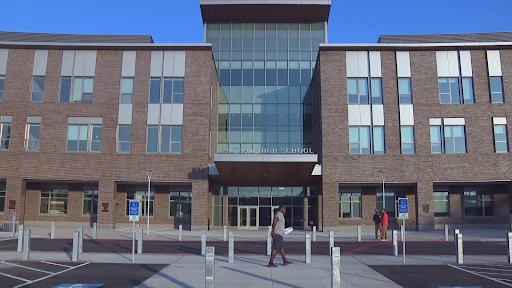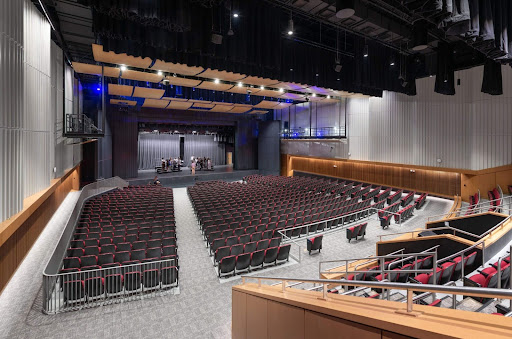As WHS students, we conducted a survey to gather student input of the numerous AP courses offered by our school. With information coming from past AP Students, you may find descriptions of each course below. Our goal is to help students feel better prepared and more confident while choosing their courses in order to succeed for years to come!
English:
AP Language & Composition
Taken mostly by: Grade 11
Student Enjoyment: 7.3/10
Average Difficulty: 5.4/10
AP Lang is a popular class that allows students to grow their analyzation skills and argumentative writing. Although the coursework can be “very repetitive” at times, it’s given to help students “adapt to a new writing style.” The majority of classwork is analyzing speeches rather than novels, and it is more writing-heavy than reading. That acknowledged, it’s safe to say that writing assignments are given for quality over quantity. Students read a few books and learn new vocabulary words to strengthen their literacy skills. A light workload makes this a low-stress AP, as long as students adhere to the “standard for the work you do.” Good note-taking skills and critical thinking will get any learner through this course.
AP Literature & Composition
Taken mostly by: Grades 11-12
Student Enjoyment: 8/10
Average Difficulty: 6/10
This reading-heavy course is for students who truly enjoy novels, poetry, writing, and finding a “deeper meaning beyond the words.” Vocabulary quizzes and weekly assignments of reading 100 pages make up the “rigorous work” as students “dive into the meaning of literature and intention of work.” This class is fun and enjoyable for students to whom this is appealing and to students who want to “appreciate really difficult texts.” Good time management and work ethic is necessary to get students through this AP.
Physical Sciences:
AP Biology
Taken mostly by: Grade 12
Student Enjoyment: 8.6/10
Average Difficulty: 7.4/10
AP Biology is a more strenuous AP course, but most students believe that it is also engaging and fun. Frequently described as “challenging, but achievable,” this 7.5 credit class gives an “in-depth look at college level bio.” The teacher is a student favorite and students often feel “inspired” by her class and its methods. With a great emphasis on studying, there is a large workload of homework most nights and regular tests. This course is described as “an accurate representation of what an AP class should be like.” In order to succeed in this class you must manage time well and use skills of “memorization and application” to “redefine your critical thinking and study habits.”
AP Chemistry
Taken mostly by: Grades 11-12
Student Enjoyment: 8.3/10
Average Difficulty: 7.8/10
AP Chemistry is for those students who “enjoyed chemistry and sophomore year and want to learn more.” Challenging labs, simulations, problem sets, and 30-60 minutes of homework each night make up the material, but “for the most part everyone pulls through.” However, this course requires a great memory and complex thinking in order to get through the “hard material.” The teacher supports students and caters to their needs in order to “learn a lot throughout the year” and succeed in AP Chemistry.
AP Environmental Science
Taken mostly by: Grades 11-12
Student Enjoyment: 5.3/10
Average Difficulty: 6/10
APES is a lab and homework heavy course for those “passionate about the environment” or who “want to learn more about how the world works.” After school, students are expected to watch 2-5 short videos after in-class games and hands-on projects. Some believe that this class is very dependent on the student’s ability to self-teach material, but once understood it is enjoyable and “a good balance of fun and learning.” Difficult FRQs and tests require students to manage their time well and pay attention to detail.
AP Physics 1
Mostly taken by: Grades 10-12
Student Enjoyment: 8.5/10
Difficulty: 6.8/10
This class is math-heavy and is a good challenge for anyone who “excelled in freshman physics.” While being very fun and engaging, it’s an extremely positive learning environment that supports students of all levels. However, the concepts are difficult to grasp, especially when you must apply certain mathematical methods towards them. This builds off of subject matter in Integrated 2 and contains an extremely fair workload with rare homework. For those “genuinely interested in physics,” this class can be “a place to think newly” about the subject and a class to truly look forward to.
Mathematics:
AP Calculus AB
Taken mostly by: Grade 12
Student Enjoyment: 6.8/10
Average Difficulty: 6.3/10
AP Calculus AB is great for those who want a challenging introduction to calculus. As a flipped classroom, this course requires students to learn material after school in order to be prepared for class. Grades are made up of only tests and quizzes, so make sure you keep up with your test-taking skills! Anyone who did well in Integrated 3 will fit into this “good mix of a challenge and easiness” where “practice makes perfect.” Mrs. Sullivan is a student favorite as well who “cares about what she does” and supports students in this challenging but well-paced subject. Although the class is difficult, “the more you study, the more you get used to the material” and succeed.
AP Calculus BC
Taken mostly by: Grade 12
Student Enjoyment: 8.2/10
Average Difficulty: 8.8/10
AP Calculus BC is 7.5 credits of fast-paced and challenging mathematics. Compared to Calculus AB, this class covers two semesters of an introductory college class instead of only one semester. Recommended to math lovers and STEM pursuers, this “difficult but not painful” class assigns daily homework with quizzes and tests every 2-3 weeks. Although “the difficult content can be very unmotivating sometimes,” it’s described as fun and engaging. The teacher is a student favorite who encourages students through a tough curriculum that’s reported as the “hardest math class in the school.” However, with enough studying and effort, AP Calculus BC can provide an invaluable calculus introduction.
AP Computer Science Principles
Taken mostly by: Grades 10
Student Enjoyment: 6.7/10
Average Difficulty: 5/10
AP Computer Science Principles is an introductory course to the field of computer science and learning the language JavaScript. It has been taught by a long term substitute in the 23-24 school year, but next year the original teacher should be back and ready to teach again. Students would say that this course is “very hands-on” and “fun”, and it is seen as an easier AP course to take here at the high school. As a slower paced class, some students find this to be too easy, or more of a “chill” class. This may be appealing to students who are new to AP because there is “rarely any homework” and “not an overbearing workload.”
AP Computer Science A
Taken mostly by: Grades 10-12
Student Enjoyment: 6.8/10
Average Difficulty: 6/10
AP Computer Science A is the second computer science AP here at the high school. In this course you learn the language Java and other “technical aspects of coding”. While taking this class, students find that “it’s not hard but it easily gets confusing.” Due to the fact that there is a new coding language being taught, it is difficult “separating the languages from each other,” but many say they “really liked the content.” As for the workload of this class, there is “not much homework, but lots of quizzes and lots of class projects.” Although there is significant classwork, the work is very manageable. One student says “the work isn’t too rigorous as long as you do everything when it’s assigned.”
AP Statistics
Taken mostly by: Grades 11
Student Enjoyment: 6.7/10
Average Difficulty: 7.7/10
“As if math and English combined to form one class,” AP Statistics provides an introduction to students for business and economics majors or simply those who enjoy mathematics. “You have to pay close attention to wording in order to earn a good grade,” says one student. There are also many vocabulary words and “the tests can take their toll.” However, this is a fascinating subject that will intrigue students of any academic background that are willing to study and put in the effort.
Social Sciences:
AP Government & Politics
Taken mostly by: Grade 10
Student Enjoyment: 7.9/10
Average Difficulty: 7.2/10
This “very rewarding” AP class builds off of AP US History (see below) and provides an in-depth curriculum of the US government. Despite the majority of students being sophomores, it is “geared towards seniors.” Taking it in 12th grade would prove advantageous due to the foundation that APUSH provides. Not only does this course inform students about the government, it helps them be “more aware about the country they live in” and “involved in their community.” This class is perfect for “history buffs”: those who enjoy politics and can put in work after school for essays, comprehensive readings, and difficult tests. In-class debates are common and provide a “nice balance of work and discussion.” With strong memorization skills and background knowledge, students can ace this “rigorous class with challenging topics.”
AP Human Geography
Taken mostly by: Grade 10
Student Enjoyment: 7.5/10
Average Difficulty: 5/10
AP Human Geography is for students who “like to learn about how the world works” and enjoy history and geography. Students explore countries and how they function in order to gain an understanding of the world around them. For “people unsure if they’d do well in an AP class,” this course provides non-stressful classwork. However, there is substantial daily homework in order to prepare students for challenging tests. There are also many projects in the workload that require students to work to understand the material and succeed.
AP Microeconomics
Mostly taken by: Grade 11
Student Enjoyment: 6.9/10
Average Difficulty: 7.2/10
Perfect for business and finance lovers, AP Microeconomics is “engaging and conceptual,” giving students real-world skills for everyday life. There are weekly readings with notes due and occasionally packets, but as long as students put in the work, it’s “very fun and easy.” There are quizzes bimonthly that encourage students to “struggle to get a higher understanding of the material.” Fast-paced and applicable, this course is right for those who can manage their time and put in the necessary effort.
AP Psychology
Mostly taken by: Grades 11-12
Student Enjoyment: 8.8/10
Difficulty: 5.8/10
AP Psychology is an “eye-opening” class that is “interesting and explains real life complexities”. Students taking AP psychology right now would say the course is “not super hard” because “there isn’t nightly homework, but there are weekly quizzes that you need to read chapters for.” This course contains an exceptional amount of memorization and requires you to be able to read every night. As an “engaging class” with amazing teachers, AP psychology helps you “improve your social skills” and provides “information that makes you more empathetic to others.” One student would describe the workload as: “it wasn’t so hard that it was super stressful, but it wasn’t so easy that I got bored. It was just challenging enough, where I had to actually work to understand the concepts.” Next year, the curriculum of the course will become more science-based and less history-based. This means learning more about the brain and how it works instead of the typical social aspect of the class.
AP US History
Mostly taken by: Grade 11
Student Enjoyment: 7.6/10
Average Difficulty: 7.7/10
AP US History is a class favored among juniors who have already taken US History 1. It is a course “for people who love history” and it is often described as “an interesting class,” but “you have to make sure you’re on top of your work.” In order to succeed in this course it is imperative that you are able to “manage time and have great work ethic.” Students recognize that this is a rigorous course and there is “homework everyday,” “a lot of work and memorization,” and “lots of tests and quizzes.” While the course is on the more difficult side, most students really love this class. One student mentioned that the content they are learning “lets [them] win jeopardy!”
World Languages:
AP Italian
Taken mostly by: Grade 12
Student Enjoyment: 6.2/10
Average Difficulty: 4/10
AP Italian is a low-stress course for those who are interested in speaking, reading, and writing Italian, as well as learning about Italian culture and customs. Those who have been learning Italian throughout their schooling would do well in this course. Assignments include AP Classroom, homework every week, and lots of classwork. “You can find it fun if you do the work and understand the course,” says a student. “It gets difficult sometimes but it is definitely not impossible,” says another, and attention and effort can get dedicated language learners through this class.
Fine Arts:
AP Studio Art
Mostly taken by: Grade 11
Student Enjoyment: 8.3/10
Average Difficulty: 8/10
Although AP Studio Art (AKA AP Drawing) isn’t a MESH class, this course is still a rigorous challenge for students who love art and can harness their creativity. Fast-paced and fun, students create a piece every 11 calendar days for a total of 15 pieces that fit within their Sustained Investigation. “You have to produce quality pieces really fast,” so this course can be stressful for those who may have trouble finding ideas or working quickly. But for art lovers and pursuers, this class gives you “a lot of freedom to just create what you want” with “access to a lot of materials.”
Waltham High School offers a broad range of AP courses with options for any student. In addition to those listed, more and more AP classes are being offered each year. We hope this article helped provide insight on the courses available at WHS and their individual qualities.
With contributions from Miyana Bahl.






